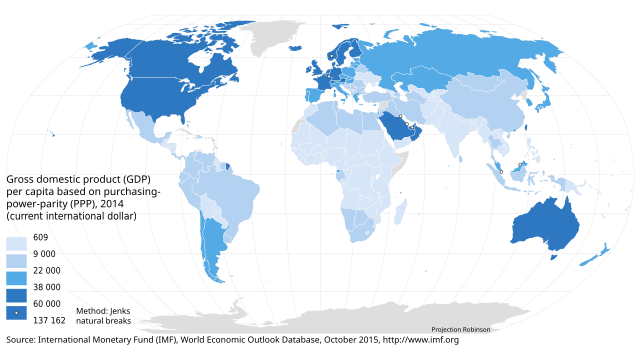ဝယ်ယူနိုင်စွမ်းအား ကွာခြားမှုနှုန်း
နိုင်ငံများ၏ဈေးနှုန်းများကိုတိုင်းတာမှု From Wikipedia, the free encyclopedia
ဝယ်ယူနိုင်စွမ်းအား ကွာခြားမှုနှုန်း (purchasing power parity သို့ PPP) မှာ နိုင်ငံနှစ်နိုင်ငံ၏ နှိုင်းရ ကုန်ဈေးနှုန်း အပေါ်တွင် မူတည်၍ ကာလအရှည်ကြာ အသုံးပြုနိုင်သော ငွေလဲနှုန်းကို တိုင်းတာသည့် ညွှန်းကိန်းတစ်ခု ဖြစ်သည်။ ထို အိုင်ဒီယာမှာ ၁၆ ရာစု ဆလာမန်ကာ ကျောင်းတော်မှ အစပြုခဲ့ပြီး ယနေ့ခေတ်တွင် ဂူစတပ်ဗ် ကပ်ဆယ်လ်က ၁၉၁၈ ခုနှစ်တွင် ဖော်ထုတ်ခဲ့သည်။ ထိုနှုန်းထားမှာ ကုန်ဈေးနှုန်း တစ်ခုတည်း ဥပဒေသ (law of one price) ပေါ်တွင် အခြေခံ၍ ဖော်ထုတ်ထားခြင်း ဖြစ်ပြီး ထိုအိုင်ဒီယာမှာ ရောင်းဝယ်ရာတွင် ကုန်ကျသည့် ငွေပမာဏနှင့် ကုန်သွယ်ရာတွင် ရှိနေသည့် တားမြစ်ချက်များကို ထည့်တွက်မထားပေ။ တူညီသော ကုန်ပစ္စည်းများသည် ကွာခြားသော ဈေးကွက်များတွင် ကြားခံငွေကြေးတစ်မျိုးတည်းဖြင့် တိုင်းတာပါက ဈေးနှုန်း အတူတူ ရှိနေလိမ့်မည်ဟု ယူဆထားခြင်း ဖြစ်သည်။


Wikiwand in your browser!
Seamless Wikipedia browsing. On steroids.
Every time you click a link to Wikipedia, Wiktionary or Wikiquote in your browser's search results, it will show the modern Wikiwand interface.
Wikiwand extension is a five stars, simple, with minimum permission required to keep your browsing private, safe and transparent.
